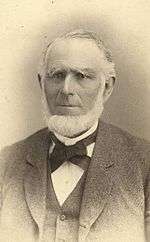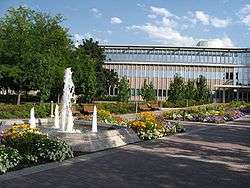Abraham O. Smoot
| Abraham O. Smoot | |
|---|---|
 Photo of A. O. Smoot by C. R. Savage. | |
| Born |
Abraham Owen Smoot February 17, 1815 Owenton, Kentucky |
| Died |
March 6, 1895 (aged 80) Provo, Utah |
| Spouse(s) |
Margaret Thompson McMeans Sarah Gibbens Emily Hill Diana Caroline Tanner Eldredge Anne Kirstine Mauritzen Hannah Caroline Rogers |
Abraham Owen Smoot (February 17, 1815 – March 6, 1895) was a Mormon pioneer in Kentucky who eventually moved to Utah. He was a businessman and politician, elected as the second mayor of Salt Lake City, Utah (1856 to 1862); and mayor of Provo, Utah, where he served from 1868 to 1881. There he was an early financial supporter of Brigham Young Academy, which developed into a college and Brigham Young University (BYU).
Smoot was among early leaders of the LDS Church who had polygamous marriages, eventually marrying six women and having 27 children, three of whom were adopted. He also was among prominent leaders in Utah who were slaveholders.
Early life
Abraham Owen Smoot was born on February 17, 1815, in Owenton, Kentucky, the son of George W. Smoot and Ann (née Rowlett) Smoot. His family moved twice in his childhood, first to southwestern Kentucky and then to the banks of the Blood River in Tennessee. His mother converted to Mormonism in 1833, and he followed her at the age of 20 in March 1835.
Missions
In February 1836, Smoot was ordained an Elder and began preaching in Kentucky and Tennessee with Wilford Woodruff, David W. Patten, and others.[1] Woodruff would later marry Smoot's niece. He named a son, Abraham Owen Woodruff, after Smoot.
Smoot moved to western Missouri in 1837. From there he embarked on a five-month proselytizing mission to southern Missouri and Arkansas in 1838. After participating in the Missouri Mormon War, Smoot moved to Montrose, Iowa. In August 1841, he left to preach in South Carolina, returning in July 1842. He led a branch of the church in Keokuk, Iowa. In 1844, he served another mission in Alabama.[2] Smoot eventually served nine proselyting missions for the Church of Jesus Christ of Latter-day Saints, in addition to two terms as ward bishop.[3]
Marriages and family
On November 11, 1838, he married Margaret Thompson McMeans in Far West, Missouri.[1]
Smoot officiated in the Nauvoo Temple during the winter of 1845-1846.[4] He began practicing polygamy in January 1846 by marrying plural wives Sarah Gibbens and Emily Hill. He eventually married three more women (Diana Caroline Tanner Eldredge, Anne Kirstine Mauritzen (also known as Anna Kristina Morrison), and Hannah Caroline Rogers) and had a total of twenty-seven children, three of whom he adopted.
His sons included Reed Smoot, born in Salt Lake City, who also became a politician and US Senator; and Brigham Smoot. A notable daughter was Ida Smoot Dusenberry. Smoot's fourth child and third daughter, Zina Beal Smoot, married apostle Orson F. Whitney.
Position on blacks
Smoot strongly supported slavery. As a missionary, he was asked to distribute literature for Joseph Smith's 1844 presidential campaign. He refused to distribute anything critical of slavery.[5] After arriving in Utah, he bought two female slaves.[6][7] He was one of the most prominent slave-owners in the territory. His position as a slave owner contributed to the legalization of slavery in Utah.[8] The 1860 Census showed he owned two male slaves.[9] One was Alex Bankhead, who rejoiced with other slaves when he was set free in 1863.[10]
Smoot was also instrumental in perpetuating the LDS priesthood ban on blacks. Under John Taylor's presidency (1880–87), the church had confusion regarding the origin of the racial policy. Elijah Abel was black and had been ordained to the priesthood. Smoot and Zebedee Coltrin provided conflicting testimony that founder Joseph Smith had said that Abel could not hold the priesthood, though the veracity of their testimony is doubted. Their accounts contributed to Taylor's decision to maintain the ban.[11][12]
Leadership in Utah
Salt Lake City
Smoot led companies of pioneers to the Salt Lake Valley in 1847, 1852, and 1856. He was an alderman from the Sugar House district from 1854 to 1857. He was elected as mayor of Salt Lake City in 1857, after the death of his business partner and then mayor Jedediah M. Grant.[13] Smoot was re-elected, serving as mayor until 1866. He also served twice as a bishop in Salt Lake City.[4]
Provo and Brigham Young Academy
Early in 1868, Brigham Young called Smoot to be president of the Utah Stake in Provo, Utah. Young was concerned with church members' unity and cooperation, and he expected Smoot to improve the situation.[14] According to family tradition, Smoot initially protested the call. After more than three decades of church and civic service, including nine missions, Smoot was apparently looking forward to enjoying the comforts brought by his hard work and successful business ventures.[15]
When Young told Smoot about the assignment, he reportedly said, "There are three places, all on a par, one is as good as the other. They are Provo, Hell, or Texas. You can take your choice."[3] Although Smoot supposedly responded, "I would sooner go to Hell than to Provo," he eventually took Provo.
By February 1868, Smoot had moved at least two of his wives and their children and a slave he had purchased[16] to the then wild and somewhat disreputable frontier town 50 miles south of Salt Lake.[14] Within a week, Smoot was elected mayor, an office he held until 1881.[17] He was a major investor in the Provo Woolen Mills, and was co-founder of a bank and a lumber company.[18]
Smoot was the first head of the board of trustees of Brigham Young Academy. Smoot is credited with making major financial contributions to the Brigham Young Academy, which allowed its continued operations. It eventually developed as a college and university. Today, the administration building at BYU is named after Smoot.
References
- 1 2 Whitney, Orson Ferguson (1904). History of Utah: Biographical. Salt Lake City: G.Q. Cannon. p. 99.
- ↑ Whitney, Orson Ferguson (1904). History of Utah: Biographical. Salt Lake City: G.Q. Cannon. p. 100.
- 1 2 Nixon, Loretta D. (1994). Abraham Smoot: A Testament of His Life. Provo, UT: Brigham Young University Press. pp. 213–214. ISBN 0842523243.
- 1 2 Whitney, Orson Ferguson (1904). History of Utah: Biographical. Salt Lake City: G.Q. Cannon. p. 101.
- ↑ Newell G. Bringhurst, Darron T. Smith. Black and Mormon. p. 38.
- ↑ Margaret Blair Young, Darius Aidan Gray. Bound for Canaan (Revised & Expanded).
- ↑ Record of members 1903-1941. Church of Jesus Christ of Latter-day Saints. Heber 3rd Ward (Utah), Film Number: 0026031 Item 1-3.
- ↑ John David Smith. Dictionary of Afro-American Slavery.
- ↑ Slave Schedule of Salt Lake County
- ↑ "Brief History Alex Bankhead and Marinda Redd Bankhead (mention of Dr Pinney of Salem)". The Broad Ax. March 25, 1899.
- ↑ Newell G. Bringhurst, Darron T. Smith. Black and Mormon. p. 38.
- ↑ W. Kesler Jackson. Elijah Abel: The Life and Times of a Black Priesthood Holder. p. 6.
- ↑ Tullidge, Edward William (1886). History of Salt Lake City. Salt Lake City: Star Printing. pp. 874–875.
- 1 2 Nixon, Loretta D. (1994). Abraham Smoot: A Testament of His Life. Provo, UT: Brigham Young University Press. pp. 213–219. ISBN 0842523243.
- ↑ Nixon, Loretta D. (1994). Abraham Smoot: A Testament of His Life. Provo, UT: Brigham Young University Press. p. 213. ISBN 0842523243.
- ↑ Pat Bagley. "Living History: Slaves arrived in Utah with Brigham Young". The Salt Lake Tribune.
- ↑ Walch, Tad (2005-11-07). "Provo's wild bunch". Deseret News. p. B1.
- ↑ Whitney, Orson Ferguson (1904). History of Utah: Biographical. Salt Lake City: G.Q. Cannon. p. 102.
External links
- Utah History Encyclopedia: Abraham Owen Smoot, media.utah.edu
- Guide to A. O. Smoot missionary diaries at the Harold B. Lee Library, Brigham Young University. Click "see diary" to see scans of the original diaries.
- A. O. Smoot papers, MSS 896 at L. Tom Perry Special Collections, Brigham Young University. Contains missionary journals and correspondence written to Abraham Smoot.
- A. O. Smoot papers, MSS 574 at L. Tom Perry Special Collections, Brigham Young University. Contains letters and patriarchal blessing.
| Political offices | ||
|---|---|---|
| Preceded by Jedediah M. Grant |
Mayors of Salt Lake City 1857–1866 |
Succeeded by Daniel H. Wells |
